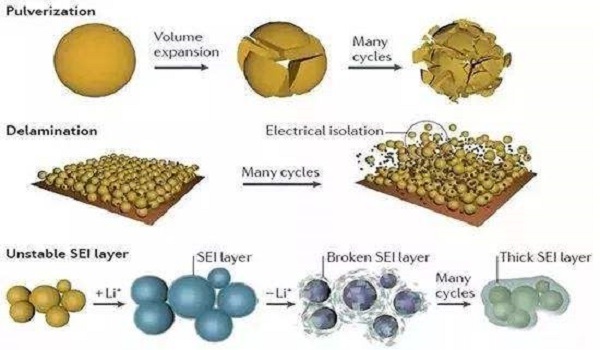The negative electrode of lithium-ion battery is made of carbon or non-carbon materials, adhesives and additives, which are mixed to make a paste adhesive evenly coated on both sides of the copper foil, and then dried and rolled. The cathode material is the main body of lithium-ion battery to store lithium, which makes lithium ions embedded and removed in the process of charging and discharging. From a technical point of view, the cathode materials of lithium-ion batteries will show diversity in the future.

With the progress of technology, the current anode materials for lithium-ion batteries have developed from a single artificial graphite to a situation in which natural graphite, mesophase carbon microsphere and artificial graphite are the main anode materials, and soft carbon / hard carbon, amorphous carbon, lithium titanate, silicon carbon alloy and other anode materials coexist.
Anode material: mostly graphite. New research finds that titanate may be a better material. Negative electrode reaction: lithium ion insertion during charging and lithium ion de insertion during discharging. Charging: xli++ xe-+ 6C → lixc6 discharging: lixc6 → xli++ xe-+ 6C
There are about six kinds of cathode materials for lithium-ion batteries: carbon cathode materials, alloy cathode materials, tin based cathode materials, lithium containing transition metal nitride cathode materials, nano materials and nano cathode materials.
The first is carbon anode materials: the anode materials actually used in lithium-ion batteries are basically carbon materials, such as artificial graphite, natural graphite, mesophase carbon microspheres, petroleum coke, carbon fiber, pyrolytic resin carbon, etc.
The second is tin based anode materials: tin based anode materials can be divided into tin oxide and tin based composite oxide. Oxide refers to the oxide of various valence metal tin. No commercial products.
The third is lithium containing transition metal nitride cathode material, which has no commercial products.
The fourth is alloy negative electrode materials, including tin based alloys, silicon-based alloys, germanium based alloys, aluminum based alloys, antimony based alloys, magnesium based alloys and other alloys. There are no commercial products.
The fifth is nano scale anode materials: carbon nanotubes and nano alloy materials.
The sixth kind of nano material is nano oxide material: according to the latest market development trend of lithium battery new energy industry in 2009, many companies have begun to use nano titanium oxide and nano silicon oxide to add to the previous traditional graphite, tin oxide and carbon nanotubes, greatly improving the charging and discharging power and charging and discharging times of lithium batteries.



